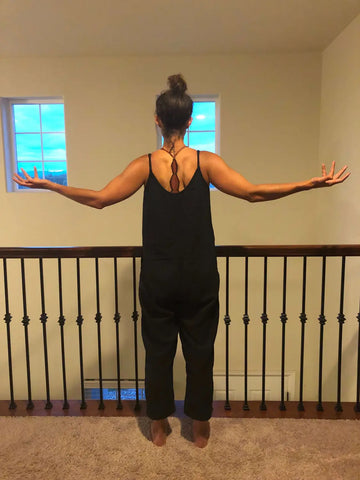Exercises to Prevent and Rehab Shoulder Injuries
Share
Exercises to Prevent and Rehab Shoulder Injuries

Like many surfers, I suffer from shoulder issues—both chronic crepitus and a more recent acute injury the causes cross-body pain. I am still able to paddle and surf, but certain movements are painful and the shoulder doesn’t feel 100% strong and stable. Shoulder injuries are common among surfers and other athletes such as swimmers, kayakers, climbers, and ball players who all perform the same arm motions over and over. Both acute shoulder injuries and repetitive use injuries can be quite debilitating. A lot of times, they result in time out of the water, arthritis, and even surgery. And the worst part about them is that they are practically inevitable for those of us who participate in these sports.
Fortunately, there are certain exercises that we can do not only to stabilize the shoulder in order to prevent injuries, but also to help rehabilitate them after injuries. Functional movement therapists believe that these exercises are essential to preventing chronic injuries and healing acute shoulder issues, and some have even found that they can help prevent surgery. The fundamental principal behind a lot of these injuries is that we modern-day humans have huge imbalances in our bodies, largely due to things like cell phones, laptops, and sitting at desks all day. We tend to develop a hunched-over, sunken-shoulder posture that is caused by—you guessed it—repetitive movements that we do during work and while scrolling on our devices. Hunching over all day and working with outstretched hands tends to over-strengthen certain muscles, such as the pecs, while our back and shoulder stabilizing muscles are neglected and become relatively weak compared to the front muscles. This all but ensures that we will eventually end up with shoulder injuries at some point, particularly if we participate in shoulder-heavy exercises such as paddling surfboards.
The solution to this is to preemptively strengthen the stabilizing muscles in our backs and rotator cuffs, while simultaneously releasing tension in our pecs. This can be achieved with a number of exercises, which will be described below.

- Scapular Retraction: This basic exercise only takes one to two minutes to do, but can have a huge impact on your shoulder stability, strength, and posture. It should be performed once per hour while working at a desk or on a laptop/per phone (preferably at the same time every hour in order to turn it into a positive habit.To perform scapular retraction exercise, stand comfortably with your legs shoulder width apart. If it helps to see yourself, consider standing in front of a mirror or reflective window. Hold your arms out to your sides perpendicular to your body, then rotate your arms so that your palms face the ceiling and your pinkies are rotating back toward the wall behind you. This should cause your shoulders to externally rotate. Keep the elbows relatively straight, although it’s okay if there is a little bend in them. Now pull the scapula together in your back, imagining that you are trying to hold a pencil between them. (Obviously you won’t be able to get them this close together, but the greater the goal you give yourself, the harder you will work and the closer you will actually get them together.) Hold this pose for one minute, keeping the scapula flexed together and the shoulders externally rotated. (This should be quite difficult at first, but eventually you will become stronger and can work your way up to two minutes). Once you have completed the exercises, release the arms and feel the way that your shoulders are naturally pulled back and your chest out, creating better posture. Now spend 30 seconds walking around your office, focusing on the feeling of that proper posture and working to ingrain the feeling into your mind. The idea is to eventually teach your body to hold this posture naturally, even when you have not recently performed the exercise.
*Eventually, as you become stronger, you may find that you want to use resistance to do modified, non-static scapular retraction exercises. Consider getting a theraband or other resistance exercise band and performing similar scapular retraction motions while pulling on the two ends of the band with both hands for resistance.
- Arm Bar: The arm bar is a great way to strengthen the small muscles of the rotator cuff, which can easily become torn or otherwise damaged. It is also a great way to stabilize the shoulder as you rehabilitate from an injury, and in some cases can serve as an effective conservative alternative to surgery. The arm bar requires a kettle bell, probably between 10 and 20 pounds, depending on your body type and strength. Lie on your side with your top leg folded over the body and lying on the floor, and the bottom arm extended out above your head, for your head to rest on. Hold the kettle bell with the top arm and extend it above your body at a 90 degree angle, externally rotating and pulling your shoulder blades together, as if you were doing a modified scapular retraction. Now “turn off” or deactivate all of the large shoulder muscles and allow the kettle bell to take control of your arm, causing it to go into a “seizure” in which it moves around almost uncontrollably, the only thing keeping it up being the small stabilizing muscles of the rotator cuff. Do this for one minute, then switch to the other side. Once you have done both sides, stand up and walk around for 30 seconds, allowing your body to internalize the retraining you have just given it. If it is difficult for you to visualize this exercise from the description above, check out this video link for a visual explanation. (Interesting side note: A friend of mine is a rock climber and injured her shoulder last year, sustaining a 75 percent tear of her labrum. She is a neuro surgeon, and got a consult with an orthopedic surgeon in her hospital, who told her that without surgery and six to eight months of recovery, she would never rock climb again. She decided to work with a functional movement trainer first, to see if she could regain some function through conservative rehabilitation. After nine months of scapular retractions and arm bars—and no surgery—she was rock climbing at full strength, doing pull-ups, and even paddling a surfboard with no pain!)
- Stretching and Self-Massage: At the same time that we are strengthening our backs and shoulders, we want to relieve the stress and tightness of the muscles that we are overusing while we work on our devices. This can involve a variety of shoulder, arm, and upper body stretches, but should also involve rolling on your upper pectoral muscles with a massage ball. Spend a couple of minutes doing this, once or twice per day, focusing on quality massage and muscle release, but being careful not to hurt yourself. If you don’t have a massage-specific ball, you can use a tennis ball, racquet ball, or lacrosse ball.
